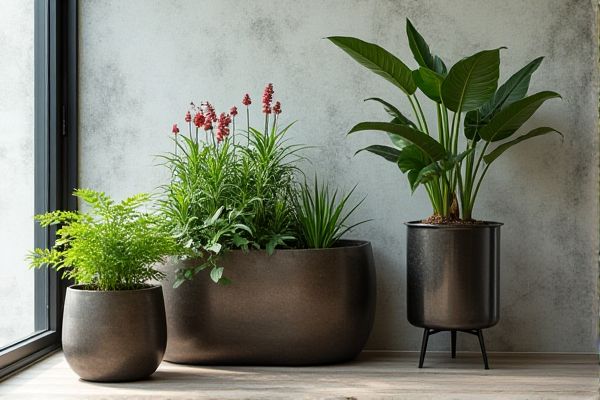
Macrame planters offer a handmade, bohemian aesthetic with natural textures that complement indoor plants, while metal planters provide a sleek, modern look with enhanced durability and weather resistance. Discover which planter style suits your space and gardening needs by exploring the rest of the article.
Table of Comparison
| Feature | Macrame Planters | Metal Planters |
|---|---|---|
| Material | Cotton or synthetic cords | Aluminum, steel, or iron |
| Durability | Moderate; prone to wear and moisture damage | High; resistant to weather and impacts |
| Weight | Lightweight and portable | Heavy; depends on metal type and thickness |
| Style | Bohemian, natural, artistic | Modern, industrial, sleek |
| Maintenance | Hand wash and air dry | Wipe clean; rust prevention needed |
| Cost | Affordable; varies with craftsmanship | Moderate to high; depends on metal quality |
| Best Use | Indoor hanging plants, decorative accents | Outdoor or indoor, larger plant arrangements |
| Environmental Impact | Eco-friendly, biodegradable materials | Recyclable but energy-intensive production |
Introduction to Macramé and Metal Planters
Macrame planters showcase intricate handwoven designs crafted from natural fibers, offering lightweight, breathable environments ideal for small indoor plants. Metal planters, often made from materials like stainless steel or aluminum, provide durable, weather-resistant homes that retain moisture for outdoor or modern indoor use. Both styles blend functionality with aesthetic appeal, catering to diverse gardening preferences and spaces.
Aesthetic Differences: Craft vs. Contemporary
Macrame planters offer a handcrafted, bohemian aesthetic characterized by intricate knots and natural textures, creating a warm, organic feel in any space. Metal planters feature sleek, contemporary designs with smooth surfaces and minimalist lines, ideal for modern or industrial decor. Choosing between these options depends on whether Your style prioritizes artisanal charm or polished, urban sophistication.
Material Durability and Longevity
Macrame planters, crafted from natural fibers such as cotton or jute, offer flexibility and aesthetic appeal but are susceptible to wear from moisture and UV exposure, reducing their durability over time. Metal planters, typically made from materials like steel, aluminum, or galvanized iron, provide superior durability and longevity due to their resistance to rust and structural integrity under various weather conditions. Choosing metal planters ensures a longer lifespan and greater protection for plants in outdoor environments compared to the more delicate nature of macrame planters.
Environmental Impact and Sustainability
Macrame planters are typically crafted from natural fibers like cotton or jute, making them biodegradable and environmentally friendly compared to metal planters, which require energy-intensive mining and processing. Your choice of macrame supports sustainability by reducing carbon emissions and minimizing landfill waste, whereas metal planters often involve non-renewable resources and can contribute to pollution during production. Opting for macrame planters aligns with eco-conscious gardening practices and promotes a greener lifestyle.
Versatility in Indoor and Outdoor Spaces
Macrame planters offer exceptional versatility with their lightweight, flexible design that easily adapts to various indoor and outdoor settings, adding a bohemian aesthetic and enabling easy hanging on walls, ceilings, or patios. Metal planters provide durability and a sleek, modern look, making them ideal for outdoor environments exposed to weather elements, while also serving as stylish, sturdy containers for indoor plants. Both options cater to different decor styles and functional needs, with macrame excelling in portability and decorative appeal, and metal planters excelling in weather resistance and structural longevity.
Weight and Portability Comparison
Macrame planters are lightweight and highly portable due to their fabric and rope construction, making them easy to hang or move indoors and outdoors. Metal planters, while durable and sturdy, tend to be heavier and less convenient to reposition frequently. The choice often depends on the need for mobility versus structural strength in planter materials.
Care and Maintenance Requirements
Macrame planters require gentle hand washing and drying to prevent fiber damage, making them ideal for low-maintenance indoor plants. Metal planters demand regular cleaning to avoid rust and corrosion, especially in humid environments or outdoor settings. Your choice depends on whether you prefer the easy upkeep of fabric or the durability of metal with occasional maintenance.
Cost Considerations: Budget vs. Investment
Macrame planters generally offer a budget-friendly option with low initial costs and customizable designs that fit various decor styles. Metal planters often require a higher upfront investment due to durable materials and modern finishes, but they provide long-term resilience and weather resistance. Choosing between the two depends on whether affordability or longevity and premium aesthetics take priority in your gardening space.
Plant Compatibility and Health
Macrame planters provide excellent air circulation and gentle support, promoting healthy root growth for indoor plants like pothos, spider plants, and ferns that thrive in well-drained environments. Metal planters excel in durability but can conduct heat and cold, potentially stressing sensitive plants such as succulents and orchids that require stable temperatures and moisture levels. Choosing between macrame and metal planters depends on the specific plant's water retention needs and environmental sensitivity to ensure optimal health and growth.
Which Planter Fits Your Style and Needs?
Macrame planters bring a bohemian, handcrafted aesthetic ideal for adding texture and warmth to your space, while metal planters offer a sleek, modern look with durability and ease of maintenance. Your choice depends on whether you prioritize natural, eco-friendly materials and a cozy vibe or require a minimalist design with weather resistance for both indoor and outdoor use. Evaluating your style preferences and the specific needs of your plants ensures you select a planter that complements your decor and supports healthy growth.
 homyna.com
homyna.com